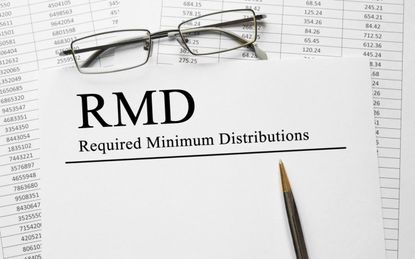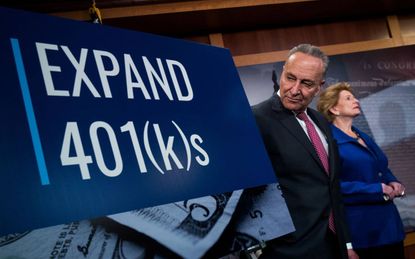10 Ways the SECURE Act Will Impact Your Retirement Savings
The new law changes the start date for RMDs, lets you contribute to an IRA longer, expands the use of 401(k) plans and much more.


With the decline of traditional pensions, most of us are now responsible for squirrelling away money for our own retirement. In today's do-it-yourself retirement savings world, we rely largely on 401(k) plans and IRAs. However, there are obviously flaws with the system because about one-fourth of working Americans have no retirement savings at all—including 13% of workers age 60 and older.
But help is on the way. On December 20, 2019, President Trump signed the Setting Every Community Up for Retirement Enhancement (SECURE) Act. This new law does several things that will affect your ability to save money for retirement and influence how you use the funds over time. While some provisions are administrative in nature or intended to raise revenue, most of the changes are taxpayer-friendly measures designed to boost retirement savings. To get you up to speed, we've highlighted 10 of the most notable ways the SECURE Act affects your retirement savings. Learn them quickly, so you can start adjusting your retirement strategy right away. (Unless otherwise noted, all changes apply starting in 2020.)

RMDs Starting at Age 72
Required minimum distributions (RMDs) from 401(k) plans and traditional IRAs are a thorn in the side of many retirees. Every year, my father grumbles about having to take money out of his IRA when he really doesn't want to. Right now, RMDs generally must begin in the year you turn 70½. (If you work past age 70½, RMDs from your current employer's 401(k) aren't required until after you leave your job, unless you own at least 5% of the company.)
The SECURE Act pushes the age that triggers RMDs from 70½ to 72, which means you can let your retirement funds grow an extra 1½ years before tapping into them. That can result in a significant boost to overall retirement savings for many seniors.

No Age Restrictions on IRA Contributions
Americans are working and living longer. So why not let them contribute to an IRA longer? That's the thinking behind the SECURE Act's repeal of the rule that prohibited contributions to a traditional IRA by taxpayers age 70½ and older. Now you can continue to put away money in a traditional IRA if you work into your 70s and beyond.
There is an impact on qualified charitable distributions (QCDs), though. Before the SECURE Act, 100% of a QCD was excluded from taxable income. Now, however, a portion of a QCD can be included in taxable income if you're age 70½ or older and deducting contributions to a traditional IRA.
As before, there are no age-based restrictions on contributions to a Roth IRA.

401(k)s for Part-Time Employees
Part-time workers need to save for retirement, too. However, employees who haven't worked at least 1,000 hours during the year typically aren't allowed to participate in their employer's 401(k) plan.
That's about to change. Starting in 2021, the new retirement law guarantees 401(k) plan eligibility for employees who have worked at least 500 hours per year for at least three consecutive years. The part-timer must also be 21 years old by the end of the three-year period. The new rule doesn't apply to collectively bargained employees, though.

Penalty-Free Withdrawals for Birth or Adoption of Child
Congratulations if you have a new baby on the way or are about to adopt a child! Right after you pass out the cigars, you'll probably start worrying about how you're going to pay for the birthing or adoption costs. If you have a 401(k), IRA or other retirement account, the new retirement law lets you take out up to $5,000 following the birth or adoption of a child without paying the usual 10% early-withdrawal penalty. (You'll still owe income tax on the distribution, though, unless you repay the funds.) If you're married, each spouse can withdraw $5,000 from his or her own account, penalty-free. Although using retirement funds for child birth or adoption expenses obviously reduces the amount of money available in retirement, lawmakers hope this new option will encourage younger workers to start funding 401(k)s and IRAs earlier.
You have one year from the date your child is born or the adoption is finalized to withdraw the funds from your retirement account without paying the 10% penalty. You can also put the money back into your retirement account at a later date. Recontributed amounts are treated as a rollover and not included in taxable income.
If you're adopting, penalty-free withdrawals are generally allowed if the adoptee is younger than 18 years old or is physically or mentally incapable of self-support. However, the penalty will still apply if you're adopting your spouse's child.

Annuity Information and Options Expanded
Knowing how much you have in your 401(k) account is one thing. Knowing how long the money is going to last is another. Currently, 401(k) plan statements provide an account balance, but that really doesn't tell you how much money you can expect to receive each month once you retire.
To help savers gain a better understanding of what their monthly income might look like when they stop working, the SECURE Act requires 401(k) plan administrators to provide annual "lifetime income disclosure statements" to plan participants. These statements will show how much money you could get each month if your total 401(k) account balance were used to purchase an annuity. (The estimated monthly payment amounts will be for illustrative purposes only.)
The new disclosure statements aren't required until one year after the IRS issues interim final rules, creates a model disclosure statement or releases assumptions that plan administrators can use to convert account balances into annuity equivalents, whichever is latest.
Speaking of annuities … the new retirement law also makes it easier for 401(k) plan sponsors to offer annuities and other "lifetime income" options to plan participants by taking away some of the associated legal risks. These annuities are now portable, too. So, for example, if you leave your job you can roll over the 401(k) annuity you had with your former employer to another 401(k) or IRA and avoid surrender charges and fees.

Auto-Enrollment 401(k) Plans Enhanced
More companies are automatically enrolling eligible employees into their 401(k) plans. Workers can always opt out of the plan if they choose, but most don't. Automatic enrollment boosts overall participation in employer-sponsored plans and encourages workers to start saving for retirement as soon as they are eligible.
The employer sets a default contribution rate for employees participating in an auto-enrollment 401(k) plan. The employee can, however, choose to contribute at a different rate. For a common type of plan known as a "qualified automatic contribution arrangement" (QACA), the employee's default contribution rate starts at 3% of his or her annual pay and gradually increases to 6% with each year that the employee stays in the plan. However, under current law, an employer cannot set a QACA contribution rate exceeding 10% for any year.
The SECURE Act pushes the 10% cap on QACA automatic contributions up to 15%, except for a worker's first year of participation. By delaying the increase until the second year of participation, lawmakers hope to avoid having large numbers of employees opt out of these 401(k) plans because their initial contribution rates are too high. Overall, the change allows companies offering QACAs to ultimately put more money into their workers' retirement accounts while keeping the potential shock of higher initial contribution rates in check.

Help for Small Businesses Offering Retirement Plans
It's simply harder to save for retirement if your employer doesn't offer a retirement savings plan, because all the work falls to you. Although most large employers have retirement plans for their workers, the same can't be said about small businesses. That's why the SECURE Act has three provisions designed to help more small businesses offer retirement plans for their employees.
First, the new law increases the tax credit available for 50% of a small business's retirement plan start-up costs. Before the SECURE Act, the credit was limited to $500 per year. However, the maximum credit amount is now up to $5,000.
Second, a brand new $500 tax credit is created for a small business's start-up costs for new 401(k) plans and SIMPLE IRA plans that include automatic enrollment. The credit is available for three years and is in addition to the existing credit described above. The credit is also available to small businesses that convert an existing retirement plan to an auto-enrollment plan.
Third, the SECURE Act makes it easier for small businesses to join together to provide retirement plans for their employees. Starting in 2021, the new law allows completely unrelated employers to participate in a multiple-employer plan and have a "pooled plan provider" administer it. This provision allows unrelated small businesses to leverage economies of scale not otherwise available to them, which typically results in lower administrative costs.

Grad Students and Care Providers Can Save More
Contributions to a retirement account generally can't exceed the amount of your compensation. So if you receive no compensation, you generally can't make retirement fund contributions. Under current law, graduate and post-doctoral students often receive stipends or similar payments that aren't treated as compensation and, therefore, can't provide the basis for a retirement plan contribution. Similar rules and results apply to "difficulty of care" payments that foster-care providers receive through state programs to care for disabled people in the caregiver's home.
Under the SECURE Act, amounts paid to aid the pursuit of graduate or post-doctoral study or research (such as a fellowship, stipend or similar amount) are treated as compensation for purposes of making IRA contributions. This will allow affected students to begin saving for retirement sooner. Similarly, "difficulty of care" payments to foster-care providers are also considered compensation under the new retirement law when it comes to 401(k) and IRA contribution requirements.

"Stretch" IRAs Eliminated
Now for some bad news: The SECURE Act eliminates the current rules that allow non-spouse IRA beneficiaries to "stretch" required minimum distributions (RMDs) from an inherited account over their own lifetime (and potentially allow the funds to grow tax-free for decades). Instead, all funds from an inherited IRA generally must now be distributed to non-spouse beneficiaries within 10 years of the IRA owner's death. (The rule applies to inherited funds in a 401(k) account or other defined contribution plan, too.)
There are some exceptions to the general rule, though. Distributions over the life or life expectancy of a non-spouse beneficiary are allowed if the beneficiary is a minor child of the account owner (but not a grandchild), disabled, chronically ill or not more than 10 years younger than the deceased IRA owner. For minor children, the exception only applies until the child reaches the age of majority. At that point, the 10-year rule kicks in.
If the beneficiary is the IRA owner's spouse, RMDs are still delayed until end of the year that the deceased IRA owner would have reached age 72 (age 70½ before the new retirement law).

Credit Card Access to 401(k) Loans Prohibited
There are plenty of potential drawbacks to borrowing from your retirement funds, but loans from 401(k) plans are nevertheless allowed. Generally, you can borrow as much as 50% of your 401(k) account balance, up to $50,000. Most loans must be repaid within five years, although more time is sometimes given if the borrowed money is used to buy a home.
Some 401(k) administrators allow employees to access plan loans by using credit or debit cards. However, the SECURE Act puts a stop to this. The new law flatly prohibits 401(k) loans provided through a credit card, debit card or similar arrangement. This change, which takes effect immediately, is designed to prevent easy access to retirement funds to pay for routine or small purchases. Over time, that could result in a total loan balance the account holder can't repay.
Get Kiplinger Today newsletter — free
Profit and prosper with the best of Kiplinger's advice on investing, taxes, retirement, personal finance and much more. Delivered daily. Enter your email in the box and click Sign Me Up.
Rocky Mengle was a Senior Tax Editor for Kiplinger from October 2018 to January 2023 with more than 20 years of experience covering federal and state tax developments. Before coming to Kiplinger, Rocky worked for Wolters Kluwer Tax & Accounting, and Kleinrock Publishing, where he provided breaking news and guidance for CPAs, tax attorneys, and other tax professionals. He has also been quoted as an expert by USA Today, Forbes, U.S. News & World Report, Reuters, Accounting Today, and other media outlets. Rocky holds a law degree from the University of Connecticut and a B.A. in History from Salisbury University.
-
 Stock Market Today: Stocks Are Mixed Before Liberation Day
Stock Market Today: Stocks Are Mixed Before Liberation DayMarkets look forward to what comes with the reordering of 80-year-old global trade relationships.
By David Dittman Published
-
 Stagflation: What It Is and Why Retirees Should Care
Stagflation: What It Is and Why Retirees Should CareStagflation — the economic bogeyman of the 1970's — may return to the US. Here's what it could mean to your retirement.
By Donna Fuscaldo Published
-
 What Does Medicare Not Cover? Eight Things You Should Know
What Does Medicare Not Cover? Eight Things You Should KnowHealthy Living on a Budget Medicare Part A and Part B leave gaps in your healthcare coverage. But Medicare Advantage has problems, too.
By Donna LeValley Published
-
 12 Great Places to Retire in the Midwest
12 Great Places to Retire in the MidwestPlaces to live Here are our retirement picks in the 12 midwestern states.
By Stacy Rapacon Published
-
 10 Cheapest Small Towns to Live In
10 Cheapest Small Towns to Live InThe cheapest small towns might not be for everyone, but their charms can make them the best places to live for plenty of folks.
By Dan Burrows Published
-
 15 Reasons You'll Regret an RV in Retirement
15 Reasons You'll Regret an RV in RetirementMaking Your Money Last Here's why you might regret an RV in retirement. RV-savvy retirees talk about the downsides of spending retirement in a motorhome, travel trailer, fifth wheel or other recreational vehicle.
By Bob Niedt Published
-
 The Cheapest Places To Retire in the US
The Cheapest Places To Retire in the USWhen you're trying to balance a fixed income with an enjoyable retirement, cost of living is a crucial factor to consider.
By Stacy Rapacon Published
-
 The Six Best Places to Retire in New England
The Six Best Places to Retire in New Englandplaces to live Thinking about a move to New England for retirement? Here are the best places to land for quality of life, affordability and other criteria.
By Stacy Rapacon Last updated
-
 13 Smart Estate Planning Moves
13 Smart Estate Planning Movesretirement Follow this estate planning checklist for you (and your heirs) to hold on to more of your hard-earned money.
By Janet Kidd Stewart Last updated
-
 Ten States With the Lowest Sales Tax
Ten States With the Lowest Sales TaxSales Tax Living in one of the lowest sales tax states doesn't always mean you'll pay less.
By Katelyn Washington Last updated

